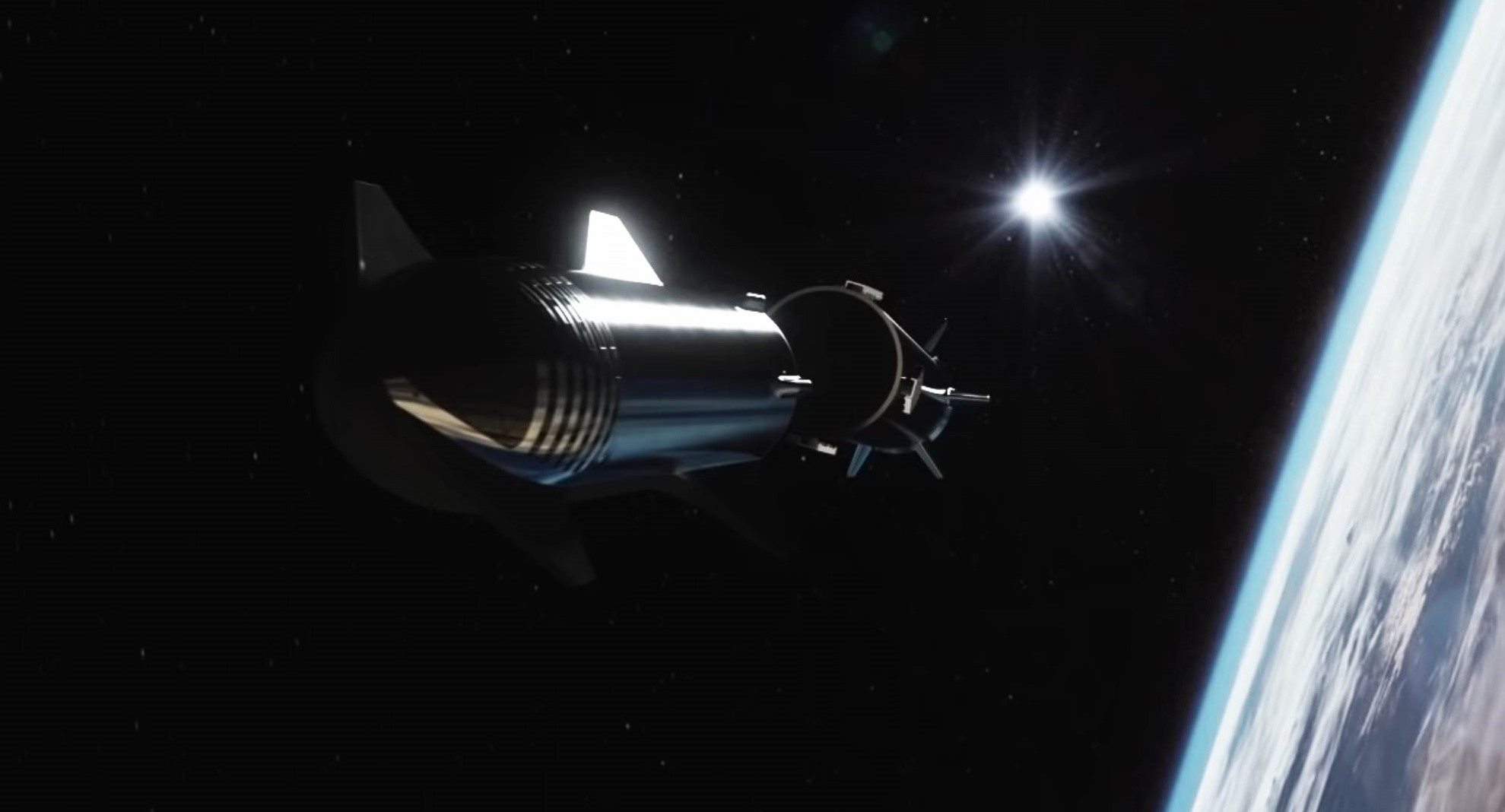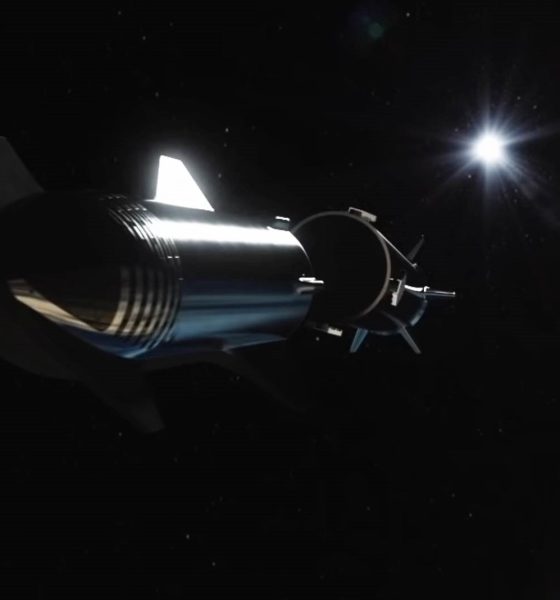

News
SpaceX reveals concrete details about Starship’s first orbital test flight
Via FCC regulatory filings, SpaceX has revealed the first concrete details about Starship and Super Heavy’s first orbital flight test.
Earlier this year, SpaceX CEO Elon Musk confirmed a shocking NASASpaceflight.com report that the company was working to launch Starship into orbit by July 2021 – the achievement of which would be nothing short of miraculous. Less than two months later, SpaceX has submitted a request for FCC permission to communicate with Starship and Super Heavy before and during an inaugural “orbital test flight” scheduled no earlier than (NET) June 20th.
Oddly, the FCC application indicates some truly unusual plans relative to the rest of SpaceX’s intensive Starship test and launch campaign.
“The Starship Orbital test flight will originate from Starbase, TX. The Booster stage will separate approximately 170 seconds into flight. The Booster will then perform a partial return and land in the Gulf of Mexico approximately 20 miles from the shore. The Orbital Starship will continue on flying between the Florida Straits. It will achieve orbit until performing a powered, targeted landing approximately 100km (~62 miles) off the northwest coast of Kauai in a soft ocean landing.“
SpaceX FCC STA Request – 13 May 2021
In short, Starship’s first orbital launch attempt aims to send an expendable prototype into space for a brief 90-minute, one-orbit spaceflight, meaning that Starship will travel once around Earth before perform a deorbit burn and attempt its first reentry. If everything goes according to plan, which is far from guaranteed, that Starship prototype will perform “a soft ocean landing” 100 km (62 mi) off the coast of the Hawaiian island Kauai. Back in the Gulf of Mexico, SpaceX’s first flightworthy Super Heavy booster will launch much like Falcon 9, separate from Starship, perform a flip and boostback burn towards Texas, and “land approximately 20 miles [32 km] from the shore.”
SpaceX says the FCC STA request is meant to “authorize Starship test vehicle communications from the launch pad at Boca Chica TX and the experimental recovery operation” following the launch but makes no reference to recovery assets in the Gulf of Mexico, leaving it ambiguous whether the first flown Super Heavy will be recovered or also perform a “soft ocean landing.” To maximize speed, choosing not to attempt to recover the first orbit-proven Starship is a logical choice for SpaceX, especially given that a fully successful orbital launch, coast, and reentry on the first attempt is a tall order.
Super Heavy, however, will be performing a maneuver virtually identical to the Falcon booster landings SpaceX has aced 75+ times over the last five years. Notably, in an included “timeline of events” for the orbital launch, SpaceX refers to Super Heavy’s landing as a “touchdown,” whereas Starship’s “soft ocean landing” is referred to as a “splashdown,” raising hopes that the booster will attempt to land on an unspecified platform a few dozen miles off the Texas coast.
Given SpaceX’s requested “operation start date” on June 20th, we wont have to wait long to find out. At the moment, SpaceX has yet to even begin stacking the first flightworthy Super Heavy booster prototype, so that NET June 20th target is far more likely to slip into July or August. Regardless, an orbital Starship launch of any kind before the end of 2021 would be nothing short of an engineering and program management tour de force for SpaceX. Stay tuned for updates as SpaceX’s orbital launch pad, Starship prototype, and booster continue to progress towards flight-readiness.

News
Tesla FSD fleet is nearing 7 billion total miles, including 2.5 billion city miles
As can be seen on Tesla’s official FSD webpage, vehicles equipped with the system have now navigated over 6.99 billion miles.

Tesla’s Full Self-Driving (Supervised) fleet is closing in on almost 7 billion total miles driven, as per data posted by the company on its official FSD webpage.
These figures hint at the massive scale of data fueling Tesla’s rapid FSD improvements, which have been quite notable as of late.
FSD mileage milestones
As can be seen on Tesla’s official FSD webpage, vehicles equipped with the system have now navigated over 6.99 billion miles. Tesla owner and avid FSD tester Whole Mars Catalog also shared a screenshot indicating that from the nearly 7 billion miles traveled by the FSD fleet, more than 2.5 billion miles were driven inside cities.
City miles are particularly valuable for complex urban scenarios like unprotected turns, pedestrian interactions, and traffic lights. This is also the difference-maker for FSD, as only complex solutions, such as Waymo’s self-driving taxis, operate similarly on inner-city streets. And even then, incidents such as the San Francisco blackouts have proven challenging for sensor-rich vehicles like Waymos.
Tesla’s data edge
Tesla has a number of advantages in the autonomous vehicle sector, one of which is the size of its fleet and the number of vehicles training FSD on real-world roads. Tesla’s nearly 7 billion FSD miles then allow the company to roll out updates that make its vehicles behave like they are being driven by experienced drivers, even if they are operating on their own.
So notable are Tesla’s improvements to FSD that NVIDIA Director of Robotics Jim Fan, after experiencing FSD v14, noted that the system is the first AI that passes what he described as a “Physical Turing Test.”
“Despite knowing exactly how robot learning works, I still find it magical watching the steering wheel turn by itself. First it feels surreal, next it becomes routine. Then, like the smartphone, taking it away actively hurts. This is how humanity gets rewired and glued to god-like technologies,” Fan wrote in a post on X.
News
Tesla starts showing how FSD will change lives in Europe
Local officials tested the system on narrow country roads and were impressed by FSD’s smooth, human-like driving, with some calling the service a game-changer for everyday life in areas that are far from urban centers.

Tesla has launched Europe’s first public shuttle service using Full Self-Driving (Supervised) in the rural Eifelkreis Bitburg-Prüm region of Germany, demonstrating how the technology can restore independence and mobility for people who struggle with limited transport options.
Local officials tested the system on narrow country roads and were impressed by FSD’s smooth, human-like driving, with some calling the service a game-changer for everyday life in areas that are far from urban centers.
Officials see real impact on rural residents
Arzfeld Mayor Johannes Kuhl and District Administrator Andreas Kruppert personally tested the Tesla shuttle service. This allowed them to see just how well FSD navigated winding lanes and rural roads confidently. Kruppert said, “Autonomous driving sounds like science fiction to many, but we simply see here that it works totally well in rural regions too.” Kuhl, for his part, also noted that FSD “feels like a very experienced driver.”
The pilot complements the area’s “Citizen Bus” program, which provides on-demand rides for elderly residents who can no longer drive themselves. Tesla Europe shared a video of a demonstration of the service, highlighting how FSD gives people their freedom back, even in places where public transport is not as prevalent.
What the Ministry for Economic Affairs and Transport says
Rhineland-Palatinate’s Minister Daniela Schmitt supported the project, praising the collaboration that made this “first of its kind in Europe” possible. As per the ministry, the rural rollout for the service shows FSD’s potential beyond major cities, and it delivers tangible benefits like grocery runs, doctor visits, and social connections for isolated residents.
“Reliable and flexible mobility is especially vital in rural areas. With the launch of a shuttle service using self-driving vehicles (FSD supervised) by Tesla in the Eifelkreis Bitburg-Prüm, an innovative pilot project is now getting underway that complements local community bus services. It is the first project of its kind in Europe.
“The result is a real gain for rural mobility: greater accessibility, more flexibility and tangible benefits for everyday life. A strong signal for innovation, cooperation and future-oriented mobility beyond urban centers,” the ministry wrote in a LinkedIn post.
News
Tesla China quietly posts Robotaxi-related job listing
Tesla China is currently seeking a Low Voltage Electrical Engineer to work on circuit board design for the company’s autonomous vehicles.

Tesla has posted a new job listing in Shanghai explicitly tied to its Robotaxi program, fueling speculation that the company is preparing to launch its dedicated autonomous ride-hailing service in China.
As noted in the listing, Tesla China is currently seeking a Low Voltage Electrical Engineer to work on circuit board design for the company’s autonomous vehicles.
Robotaxi-specific role
The listing, which was shared on social media platform X by industry watcher @tslaming, suggested that Tesla China is looking to fill the role urgently. The job listing itself specifically mentions that the person hired for the role will be working on the Low Voltage Hardware team, which would design the circuit boards that would serve as the nervous system of the Robotaxi.
Key tasks for the role, as indicated in the job listing, include collaboration with PCB layout, firmware, mechanical, program management, and validation teams, among other responsibilities. The role is based in Shanghai.
China Robotaxi launch
China represents a massive potential market for robotaxis, with its dense urban centers and supportive policies in select cities. Tesla has limited permission to roll out FSD in the country, though despite this, its vehicles have been hailed as among the best in the market when it comes to autonomous features. So far, at least, it appears that China supports Tesla’s FSD and Robotaxi rollout.
This was hinted at in November, when Tesla brought the Cybercab to the 8th China International Import Expo (CIIE) in Shanghai, marking the first time that the autonomous two-seater was brought to the Asia-Pacific region. The vehicle, despite not having a release date in China, received a significant amount of interest among the event’s attendees.








